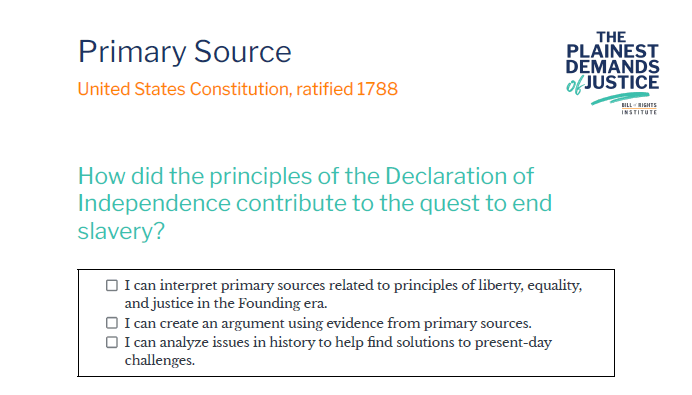Excerpts from the U.S. Constitution, ratified 1788
Get the Scaffolded Version
How did the principles of the Declaration of Independence contribute to the quest to end slavery?
- I can interpret primary sources related to principles of liberty, equality, and justice in the Founding era.
- I can create an argument using evidence from primary sources.
- I can analyze issues in history to help find solutions to present-day challenges.
Essential Vocabulary
| Posterity | Future generations |
| Ordain | To decree or command |
| Apportioned | Allocated |
Building Context
The delegates to the Constitutional Convention held in Philadelphia from May to September 1787 established a system of republican government that is emulated throughout the world. The final document they created made no mention of the words slave, race, or color, yet the debate over the institution of slavery exposed divisions among the delegates. Two of the most contentious issues at the convention—counting state populations for representation in Congress and continuing the international slave trade—sparked intense discussion. North Carolina, South Carolina, and Georgia refused to commit to a document without some guarantees of slavery. After 17 weeks of deliberation, the Philadelphia convention approved a draft of the Constitution to submit to popular conventions in the states for ratification.
The Constitution of the United States
Source: https://billofrightsinstitute.org/primary-sources/constitution
Preamble: We the People of the United States, in Order to form a more perfect Union, establish Justice, insure domestic Tranquility, provide for the common defence, promote the general Welfare, and secure the Blessings of Liberty to ourselves and our Posterity [future generations], do ordain [decree or command] and establish this Constitution for the United States of America.
Article I, Section 2. [Three-Fifths Clause]
….Representatives and direct Taxes shall be apportioned [allocated] among the several States which may be included within this Union, according to their respective Numbers, which shall be determined by adding to the whole Number of free Persons, including those bound to Service for a Term of Years, and excluding Indians not taxed, three fifths of all other Persons.
Article I, Section 9. [Slave Trade Clause]
…
The Migration or Importation of such Persons as any of the States now existing shall think proper to admit, shall not be prohibited by the Congress prior to the Year one thousand eight hundred and eight, but a Tax or duty may be imposed on such Importation, not exceeding ten dollars for each Person.
Article IV, Section 2. [Fugitive Slave Clause]
…
No Person held to Service or Labour in one State, under the Laws thereof, escaping into another, shall, in Consequence of any Law or Regulation therein, be discharged from such Service or Labour, but shall be delivered up on Claim of the Party to whom such Service or Labour may be due.
Comprehension and Analysis Questions
- According to the Preamble, what is the purpose of the U.S. Constitution? Are there phrases in the Preamble that support or refute the institution of slavery? Explain.
- The excerpted sections from Articles I and IV pertain to slavery but never use the term. Why do you think the Founders deliberately chose to do this?
- To what extent is the Constitution a document based on principles? To what extent is it based on the reality of compromise?
- Several southern states insisted on accommodations to slavery as a condition of ratification. How, if at all, could you rewrite or amend the slavery clauses above without negating the possibility of ratification, and without explicitly recognizing a right to hold human beings as property? What would it mean if the southern states were not included in the ratification process?
